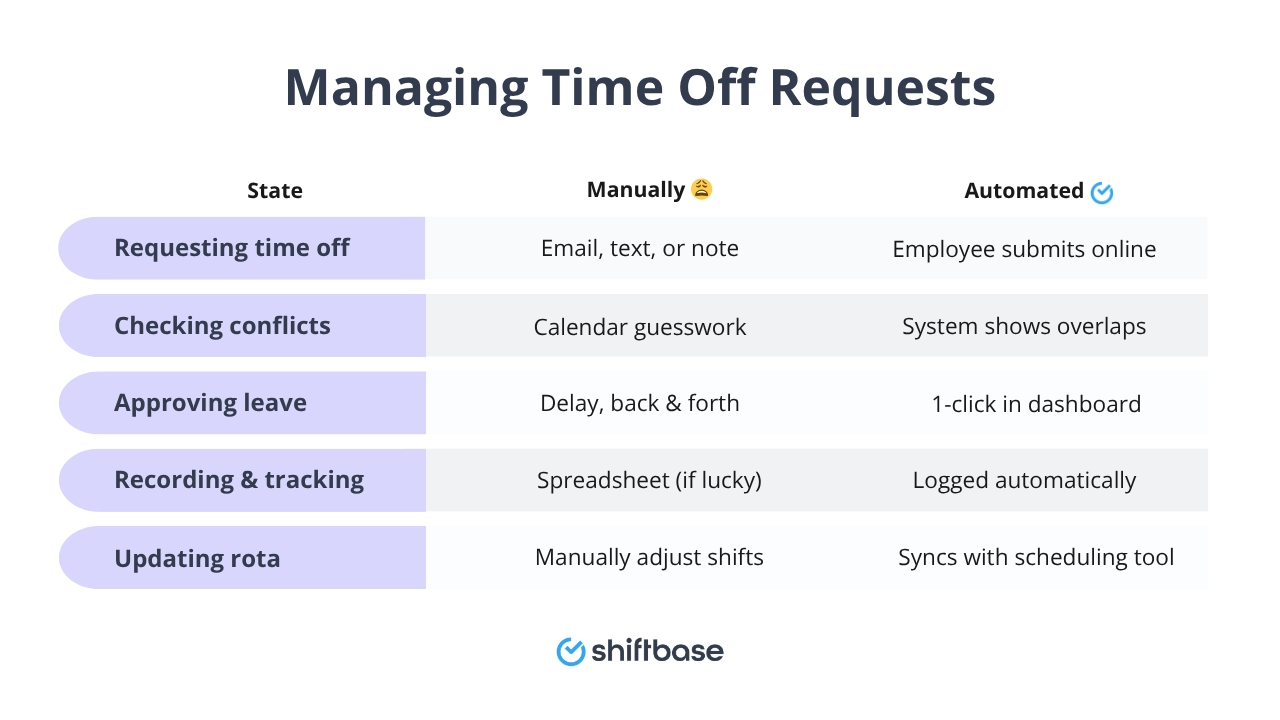This guide covers everything employers need to know to manage time off requests; from types of leave and legal obligations to fair approval practices and automation tools.
What are time off requests?
A time off request is when an employee asks not to work on a specific day (or days). It might be for a holiday, a personal reason, or even something unexpected like illness or a family emergency.
As a manager, you’re the one who gets these requests and decides whether to approve them, based on staffing needs, company policy, and sometimes the law.
Having a clear system for handling time off requests keeps things fair, avoids rota chaos, and helps everyone plan better (you included!).
Types of time off requests
Not all time off is the same. Some types are legally protected, while others are just nice to offer as part of good company culture. Here’s a breakdown of the most common ones you’ll deal with:
🏖️ Annual leave (holiday)
-
This is the standard paid time off that employees are entitled to each year.
-
In the UK, full-time workers must get at least 28 days (including bank holidays).
-
Employees usually request this in advance; some companies have rules like “give at least two weeks’ notice”.
🤒 Sick leave
-
When someone’s too ill to work, they can take Statutory Sick Pay (SSP) if they qualify.
-
From April 2025, SSP waiting days are being scrapped, so employees get paid from day one.
-
It’s a legal right, but you can ask for a fit note after 7 days off.
👶 Parental leave
-
This includes maternity, paternity, adoption, and shared parental leave.
-
From April 2025, there are also new rights for neonatal care leave and miscarriage leave.
-
These are more regulated, with rules around notice periods and pay depending on the type.
🍼 Time off for dependants
-
Unpaid time off to deal with family emergencies; like a child being ill or care responsibilities.
-
Employers can’t refuse it, but it’s meant to be short term.
🧘♀️ Compassionate or bereavement leave
-
This isn’t always legally required, but more employers now offer it.
-
From October 2025, there’ll be a legal right to miscarriage leave, even before 24 weeks of pregnancy.
✈️ Unpaid leave
-
Used when someone runs out of paid leave but still needs time off.
-
This one’s flexible; it’s up to the employer to allow it or not.
🎓 Study or training leave
-
In some cases, employees can ask for time off to study or train (usually if your company has 250+ employees).
-
Whether it's paid or unpaid depends on your company policy.
How to manage time off requests fairly
It’s easy to say “first come, first served”, but in reality, managing time off may be more complicated than that. The key is to be clear, consistent, and human.
Here’s how to stay fair (and sane):
Set a clear time off policy
-
Put it in writing: who’s entitled to what, how to request time off, how far in advance, and how decisions are made.
-
Make sure it’s easy to find in your staff handbook or HR platform.
-
Keep it up to date with new laws, like neonatal leave and SSP changes coming in 2025.
💡Tip: Your policy shouldn’t just say “manager’s discretion”; that’s how you get complaints.
Plan ahead with a shared calendar
-
Use a shared calendar or leave management tool to avoid clashes.
-
Block out busy periods (e.g., Christmas, school holidays) where cover is tight.
-
Let employees see who else is off; it helps them pick better dates.
Set deadlines and notice periods
-
Decide how much notice is needed (e.g., two weeks for holiday, more for longer leave).
-
Be flexible for emergencies, like sick leave or time off for dependants.
-
You can refuse holiday requests if they clash with business needs, but do it fairly and in writing.
Use fair decision-making rules
When two people want the same days off, how do you choose?
You could:
-
Go by first come, first served
-
Rotate priority during peak periods (so the same person doesn’t always miss out)
-
Consider personal situations (e.g. childcare, religious holidays)
-
Balance fairness with business needs
⚠️ Just make sure the rules are clear and apply to everyone equally.
Communicate clearly and kindly
-
Approve or reject requests as quickly as you can.
-
Explain the reason if it’s a no; don’t just ignore it.
-
Avoid favouritism or inconsistent decisions (this is where managers often get tripped up).
Track everything
-
Keep a record of who’s off, when, and why.
-
This helps with payroll, cover planning, and avoiding accidental over-approval.
-
Many tools (like Shiftbase) make this automatic.
Legal considerations you should actually care about
Lets look at what employers need to know to make sure they're staying on the right side of the law:
Annual leave: it’s a legal right
-
Full-time employees are entitled to 28 days of paid holiday per year (that’s 5.6 weeks).
-
This includes bank holidays, unless your contract says otherwise.
-
You can say no to a requestif there’s a valid business reason; but you must give notice that’sat least as long as the time off requested (e.g., 1 week’s notice to deny a 1-week holiday).
💡 You can’t just say “use it or lose it” unless the employee had a fair chance to take their holiday.
Sick leave and SSP (Statutory Sick Pay)
-
In 2025, SSP kicks in from day one (no more 3 unpaid ‘waiting days’).
-
You pay £116.75 per week (rate as of April 2025) for up to 28 weeks.
-
You can ask for a fit note after 7 calendar days off.
💡Make sure your absence policies are updated for the new SSP rule.
Family-related leave (and what’s new)
Here’s what’s legally required right now:
| Type of Leave | Entitlement |
|---|---|
| Maternity leave | Up to 52 weeks (39 paid), regardless of length of service |
| Paternity leave | 2 weeks paid leave – now requestable from day 1 (from April 2025) |
| Shared parental leave | Up to 50 weeks shared between parents |
| Neonatal leave | Up to 12 weeks paid leave if baby is in hospital >7 days (from April 2025) |
| Miscarriage leave | Legal right to time off before 24 weeks (from Oct 2025) |
These types of leave are protected; you can’t penalise employees for using them.
Time off for dependants
-
Employees have the right to unpaid time off for emergencies (e.g., sick child, sudden breakdown in care).
-
It doesn’t have to be approved in advance, but it’s meant to be short and occasional.
Discrimination and fairness
-
Saying “no” to a time off request? Be consistent and document your reasoning.
-
Make sure decisions don’t unintentionally discriminate based on:
-
Religion (e.g., time off for a religious holiday)
-
Disability (e.g., medical appointments)
-
Pregnancy or parental status
-
What happens if you get it wrong?
-
Employees can take you to a tribunal if they think they were unfairly denied leave, or treated differently for using their legal rights.
-
Fines, back pay, bad press, and low morale follow quickly after.
Time-off request automation

Time off automation means using software to handle the whole process (requests, approvals, tracking) without spreadsheets or paperwork. It’s faster, fairer, and way less faff.
Here’s what it looks like in real life:
How it works
-
Employees log into a system (like Shiftbase) and send a request for time off
-
The manager gets a notification, sees conflicts or busy dates, and approves or declines in a click
-
The calendar updates automatically and logs the time off for records and payroll
-
Everyone stays in the loop—no chasing, no lost emails, no drama
Why it saves you headaches
-
No more double bookings: See instantly who’s off when
-
Faster approvals: You’re not digging through emails or WhatsApp messages
-
Better records: Full history for audits, payroll, and legal backup
-
Smarter planning: See trends like who hasn’t taken any holiday (or who’s taken a lot)
-
Fewer “But I asked last month!” arguments: Everything’s tracked and time-stamped
What to look for in a good tool
When choosing time off software, look for:
-
Employee self-service portal (easy to request + view balance)
-
Manager dashboards (to approve, deny, or comment)
-
Conflict alerts (so you know if two people clash)
-
Integration with scheduling and payroll
-
UK compliance features (e.g. SSP tracking, parental leave categories)
💡Bonus: Some systems even help you analyse absence trends, like team burnout or late cancellations.
Make time off management ridiculously easy with Shiftbase
Managing time off doesn’t have to feel like herding cats. With Shiftbase, it’s all automated, all connected, and just works. Whether you're trying to approve leave, keep the rota covered, or stop staff from hoarding holidays until Christmas, we’ve got you sorted.
Shiftbase is an all-in-one workforce management software that brings your employee scheduling, time tracking, and absence management into one simple system. That means no more messy spreadsheets, last-minute rota panics, or “Oh no, I forgot I approved that” moments.
When someone sends a time off request:
-
Managers get real-time alerts with all the info they need (like overlapping shifts)
-
Approvals take one click, not a chain of emails
-
Schedules update automatically, and everyone stays in the loop
-
Absence reports and leave balances stay accurate—no extra admin
💡 Oh, and it’s all cloud-based, so you can manage your team’s time off from your desk, your phone, or even the beach (if you're lucky).
👇 Try Shiftbase for free
Want to see how easy it can be to manage time off, rota planning, and leave tracking in one place? 👉 Start your free 14-day trial today—no credit card needed, just less chaos.

- Automatic accrual of vacation hours
- Request leave easily
- Leave registrations visible in the planning



